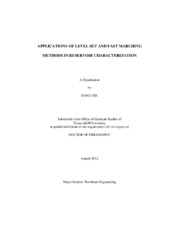| dc.contributor.advisor | Datta-Gupta, Akhil | |
| dc.contributor.advisor | Efendiev, Yalchin | |
| dc.creator | Xie, Jiang | |
| dc.date.accessioned | 2012-10-19T15:30:53Z | |
| dc.date.accessioned | 2012-10-22T18:02:41Z | |
| dc.date.available | 2012-10-19T15:30:53Z | |
| dc.date.available | 2012-10-22T18:02:41Z | |
| dc.date.created | 2012-08 | |
| dc.date.issued | 2012-10-19 | |
| dc.date.submitted | August 2012 | |
| dc.identifier.uri | https://hdl.handle.net/1969.1/ETD-TAMU-2012-08-11778 | |
| dc.description.abstract | Reservoir characterization is one of the most important problems in petroleum engineering. It involves forward reservoir modeling that predicts the fluid behavior in the reservoir and inverse problem that calibrates created reservoir models with given data. In this dissertation, we focus on two problems in the field of reservoir characterization: depth of investigation in heterogeneous reservoirs, and history matching and uncertainty quantification of channelized reservoirs.
The concept of depth of investigation is fundamental to well test analysis. Much of the current well test analysis relies on analytical solutions based on homogeneous or layered reservoirs. However, such analytic solutions are severely limited for heterogeneous and fractured reservoirs, particularly for unconventional reservoirs with multistage hydraulic fractures. We first generalize the concept to heterogeneous reservoirs and provide an efficient tool to calculate drainage volume using fast marching methods and estimate pressure depletion based on geometric pressure approximation. The applicability of proposed method is illustrated using two applications in unconventional reservoirs including flow regime visualization and stimulated reservoir volume estimation.
Due to high permeability contrast and non-Gaussianity of channelized permeability field, it is difficult to history match and quantify uncertainty of channelized reservoirs using traditional approaches. We treat facies boundaries as level set functions and solve the moving boundary problem (history matching) with the level set equation. In addition to level set methods, we also exploit the problem using pixel based approach. The reversible jump Markov Chain Monte Carlo approach is utilized to search the parameter space with flexible dimensions. Both proposed approaches are demonstrated with two and three dimensional examples. | en |
| dc.format.mimetype | application/pdf | |
| dc.language.iso | en_US | |
| dc.subject | Reservoir Characterization | en |
| dc.subject | Level Set and Fast Marching Methods | en |
| dc.subject | Depth of Investigation | en |
| dc.subject | Unconventional Reservoirs | en |
| dc.subject | History Matching | en |
| dc.subject | Channelized Reservoirs | en |
| dc.title | Applications of Level Set and Fast Marching Methods in Reservoir Characterization | en |
| dc.type | Thesis | en |
| thesis.degree.department | Petroleum Engineering | en |
| thesis.degree.discipline | Petroleum Engineering | en |
| thesis.degree.grantor | Texas A&M University | en |
| thesis.degree.name | Doctor of Philosophy | en |
| thesis.degree.level | Doctoral | en |
| dc.contributor.committeeMember | King, Michael; Zhu, Ding | |
| dc.type.genre | thesis | en |
| dc.type.material | text | en |


